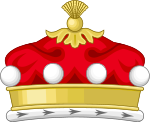| Baron Ampthill | |
|---|---|
  Arms of Russells, Barons Ampthill: Argent, a lion rampant gules, on a chief sable three escallops argent, a mullet or for difference. | |
| Creation date | 11 March 1881 |
| Created by | Queen Victoria |
| Peerage | Peerage of the United Kingdom |
| First holder | Odo Russell, 1st Baron Ampthill |
| Present holder | David Russell, 5th Baron Ampthill |
| Heir presumptive | Anthony John Mark Russell |
| Remainder to | the 1st Baron's heirs male of the body lawfully begotten. |
Baron Ampthill, of Ampthill in the County of Bedfordshire, is a title in the Peerage of the United Kingdom. It was created on 11 March 1881 for the diplomat Lord Odo Russell. He was the third son of Major-General Lord George Russell, second son of John Russell, 6th Duke of Bedford.
Contents
His son, the second Baron, served as Governor of Madras from 1899 to 1906 and was interim Viceroy of India in 1904. His grandson, the fourth Baron, was one of the ninety elected hereditary peers that remained in the House of Lords after the passing of the House of Lords Act 1999, and sat as a cross-bencher. As of 2014 [update] the title is held by the latter's son, the fifth Baron, who succeeded his father in 2011.
